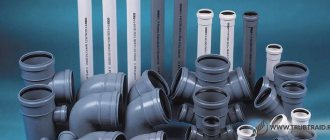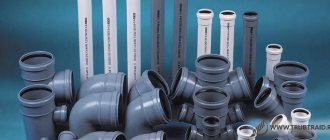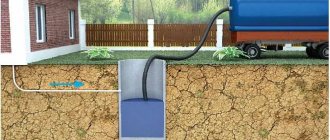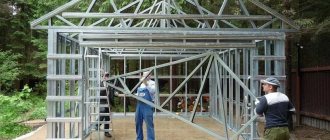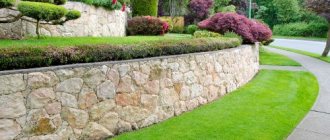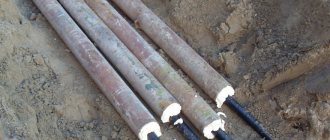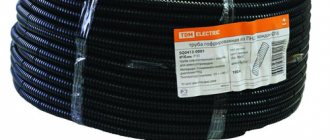Timely and effective drainage of water is important not only for the foundation of a building or garden plot. Drainage plays an equally important role in the construction of roads and railways. Spring floods, heavy rainfall in autumn, snow in winter, and so on, can easily turn a highway into a pond.
Choosing a pipe for the road
This problem is solved by installing special structures.
culvert
A culvert is a cheaper and more accessible alternative to a bridge. The construction of the road involves the formation of an embankment. It has to be laid in varied terrain and taking into account the fact that ditches, hollows, meadows and so on in the spring and autumn will turn into rivers and movement along the route may be stopped. In some cases, a bridge is built to overcome such obstacles.
However, this is an expensive undertaking. Therefore, more often than not, an embankment is constructed in the usual manner, and the problem of draining melt and rainwater is solved by laying pipes under the road.
Their sizes are very impressive - from 0.5 to 4 m in diameter. Therefore, they are sometimes used to construct pedestrian tunnels. They are also used as drainage, but only for draining water, not collecting it - perforation is not allowed here.
It is best to lay the pipe under the road during embankment construction, but other solutions are possible.
The process of laying pipes in a ditch under the road
The whole process consists of the following steps:
- Cleaning the ditch with the subsequent creation of slopes and its expansion. The width at the bottom should be equal to the diameter of the pipe +40 cm.
- A geo-textile is laid at the bottom of the ditch. This will prevent the sand from above from sinking into the soil below.
- Preparing a cushion of sand and crushed stone of fraction 20-40. When compacted, the layer should be 10-15 cm. The density of the pillow should be about 95% according to Proctor. This means that if you stand on this layer, it should not sag under your feet.
- Pipe laying.
- Back layer of sand or soft soil. Tamping 95% according to Proctor. The top layer above the pipe should be at least 30 cm.
- Laying geo-fabric on a pillow.
- Backfilling crushed stone and compacting it.
- Making the upper part of the race.
- Strengthening slopes with geogrid or concreting.
If a drainage pipe is placed under the road during construction work and heavy equipment traffic is expected, then as an option, temporary laying of road slabs on top can be used.
Advantages
- When laying a culvert under the road, the embankment remains intact and is not separated by sections from the bridge, which ensures higher strength of the highway.
- The drainage canal can be built after the construction of the embankment; this will not affect the quality of the route. When the direction of wastewater changes or the calculations are incorrect, installing a culvert under the road is often the only solution.
- It is much faster to build a canal than a bridge. This solution is not only cost-effective, but also the fastest.
- Laying pipes under a road is much cheaper than building a road or railway bridge. Accordingly, the total cost of construction is reduced.
Purpose of the pipe for the ditch
To solve the problem of water accumulation and at the same time the passage of vehicles through such a pit, laying a pipe in a dug ditch and creating a flat surface above it will help.
Thanks to such a pipe, you can significantly improve the performance of your summer cottage
In order to prevent water from accumulating near or on a summer cottage, it is customary to build a structure from a wide pipe through which water will flow from one section of the pit to another.
If the driveway to the house is simply covered with soil, then water will accumulate and wash away this embankment. To prevent this from happening, it is necessary to ensure unhindered outflow of water. To do this, it is customary to use a wide pipe, which can then be covered with soil.
When forming such a design, the following points must be taken into account:
- The weight of vehicles that will move along such a construction. If you have a truck or tractor, you should use a high-strength product.
- Width and depth influence the determination of the diameter, which depends on the volume of accumulated water. This is often a trench 1 m deep and 2 m wide.
- The costs of building an embankment must be calculated in advance, since they vary in each individual option.
When choosing the type of structure, you must remember that a long and narrow product will become clogged more often. It will be difficult to clean it.
Concrete and reinforced concrete structures
Today, concrete drainage channels are the most popular for a number of reasons.
- The cost is the most affordable. Reinforced ones, that is, reinforced concrete ones, cost a little more, but still less than finished metal or plastic products.
- Versatility - concrete pipes for the road can be purchased ready-made (reinforced concrete ones too), or they can be produced directly at the construction site. In cases where delivery of materials is difficult or impossible, a drainage canal is constructed directly on the site: formwork reinforced with iron pins is built and filled with concrete.
This option slows down the pace of construction, since concrete takes a long time to gain strength, but sometimes it is the only possible one.
- Strength – the design is designed for laying under a road or railway, so the strength of the product is enormous: concrete drainage systems can withstand earthquakes up to magnitude 9. The photo shows a concrete drainage system.
What is a culvert
Before we delve into the parameters and characteristics of the products, let's clarify what concrete road pipes are?
- A culvert is an artificially created structure whose main task is to pass free-flow watercourses passing under road embankments.
- Depending on the characteristics of the area, such structures can be built not only for the passage of water, but also for the movement of pedestrians, vehicles or livestock being driven.
- The pipe body, located in bulk soil, is assembled from individual elements - links. They are the main products, the production of which is regulated by standard 24547.
- On both sides, the pipe is limited by caps that provide unhindered through passage of water flow and hold the earthen slope.
Culvert structure
Attention! Let’s say right away that concrete pipes for ditch, which are laid in ditches to drain water from areas, or if you need to make a culvert under the entrance to the yard, are completely different products, manufactured in accordance with GOST 20054 * 2016.
Reinforced concrete pipe in a ditch
To drive into the yard, you can also use a polymer corrugated pipe - the price is lower and it’s easier to install it yourself
Parameters and sizes
There are 6 types of links in total, from which reinforced concrete road pipes are assembled.
Which ones exactly can be seen in the table:
| Product brand and sizes | Link shape and section |
The diameter of the product is set without taking into account the wall thickness (that is, internal), and is:
There are only three length options:
|
|
For this type of links the same standard sizes are provided as for round ones. |
|
Since these are the input elements of the culvert, their parameters are selected based on intermediate links. |
|
The standard size of arched links is determined by the internal horizontal diameter. This:
Length:
|
|
The standard dimensions of ovoid links are the same as those of arched ones, only here the vertical diameter is taken into account rather than the horizontal one. |
|
In rectangular links, the clear width of the product is taken into account:
Available in five lengths:
|
|
Please note: Other pipe parameters - not only length, but also diameters - can be manufactured by the factory for a specific project.
Other characteristics, delivery conditions
According to their load-bearing characteristics, links for culverts are divided into 3 groups.
Here the main criterion is the estimated height of the soil backfill:
- 2 meters;
- 4 meters;
- 6 meters.
Note: When individually manufacturing pipes with non-standard parameters, their calculated load-bearing capacity may also change.
Small diameter pipes can be supplied assembled
Links with a round cross-section, as a rule, are supplied to the consumer already assembled or in larger units. In this case, all that remains is to install it in place. However, large-sized products with complex configurations are shipped in the form of prefabricated elements.
Marking
They are marked with one or two groups of numbers and letters. The first contains information on the type and nominal dimensions of the link in centimeters. The second group of designations, which is written with a hyphen, is usually provided for products designed for special operating conditions.
Example of link markings
It encrypts the type of aggressive influence:
- M – operation at temperatures below – 40 degrees;
- K – acidic environment;
- Sh – alkaline environment.
The second part of the marking also contains information about the density of the concrete from which the product is made and the group of its load-bearing capacity.
Note: In general, GOST allows products to be labeled according to the manufacturer’s own standards - especially when non-standard options are produced. The main thing is that the design of the link is confirmed by calculations, on which confidence in the safety and reliability of the future pipe is based.
Plastic pipeline
Appeared relatively recently. Plastics are not high-strength materials, and reinforced products are expensive. But a modern plastic pipe corrugated for the road can handle the load quite well.
- Products of sufficient hardness are selected for this purpose – class 14–16. And in fact, it is impossible to build such a structure without the feasible participation of concrete. Drainage systems are laid on a concrete foundation - block or monolithic, and covered with a concrete arch on top. To strengthen the structure, it is reinforced with metal boxes with boulders.
A plastic culvert of small diameter is often used as a drainage pipeline in private households: in dachas, garden plots, and country houses. If we are talking about laying under a road with a small load, polyethylene corrugated products are completely justified. To lay them under the road, steel casings are used, but the cost of both the structure and the work itself still remains affordable.
Types of drainage pipes
The choice of drainage pipes depends entirely on the load that will be placed on them. Therefore, the main criteria that are followed when purchasing a pipe for a ditch are:
- reliability and mechanical strength;
- weight and dimensions.
In addition, the cost of tubular products, as well as their installation and transportation, must also be taken into account.
Reinforced concrete, steel and plastic pipes are suitable for drainage installations.
| Steel | They are popular due to the reasonable cost of the product itself, installation work, and delivery, as well as sufficient strength. Laying such a pipe is easy to do with your own hands. | The only weak point of steel pipes is their low corrosion resistance. The problem can be solved by using thick-walled products or additional waterproofing coating. |
| Reinforced concrete | A concrete pipe consists of a reinforcing frame filled with concrete. Durable and reliable, not subject to corrosion. Variability of products: the pipe is made in various sizes (diameter can be from 30 to 120 cm, with wall thickness from 1.4 to 4 cm, length from 2.5 to 5 m), inert to chemical compounds, able to withstand high and low temperatures loads, fireproof. The pipe can last up to 100 years. | The weight of the pipes is from half a ton to one and a half tons, which makes its transportation and installation difficult. Installation requires the use of special equipment. Installing such a pipe is expensive. |
| Plastic corrugated | The raw materials for the pipes are virgin polyethylene and high-strength polypropylene, resulting in a monolithic, durable product. The diameter of such pipes can be relatively small or very large (range - from 2 to 100 cm, wall size - 2.2 - 14 cm, product length from meter to 6). The pipe has elasticity, bending under load, and when the pressure is released, it does not deform, but returns to its original position. The outer shell protects the pipe walls without weighing it down. It is easy to install and clean, and if you lay it on a slope, then cleaning is not required, the smooth walls do not retain solid impurities and the pipe cleans itself. Lightweight. Economical in price. | Afraid of open fire and UV radiation. |
We recommend that you read: Using metal corrugation for cable wiring
The choice of pipes largely depends on financial capabilities, so most often steel pipes are laid in the ditch at the entrance, as the most cost-effective option.
Installation procedure
Step 1. The bottom of the dug trench is covered with a 15-centimeter sand “cushion”, which will contribute to a more even distribution of loads.
Step 2. Next, lay a separator made of medium-density geotextile on top of the sand. This, by the way, is a unique material that has excellent reinforcing and filtration characteristics. That is why there are simply no alternatives to geotextiles today. Read more about geotextiles here.
Step 3. You don’t have to stitch the fabric - just lay it with an overlap of 20 centimeters. Lay at least a 10cm layer of crushed stone on top of the geotextile to serve as a base for the drainage pipe. Now you can begin directly installing the pipe in the trench.
Corrugated pipe
Today this is a fairly common material that has earned the trust of many. It is a product (double-walled) with a diameter of 200-1000 mm. Wall thickness varies from 22 to 130 mm. This product is 1-6 m long.
Here the layers are soldered monolithically to each other. The raw material is primary high-density polyethylene or polypropylene.
It is recommended to check the strength and elasticity by pressing on the edge. In soft material, the dent that forms will not return to its previous shape due to the presence of an abundance of various impurities. The outer layer of corrugation is a protective lightweight frame, with the help of which the manufacturer can achieve greater rigidity, as well as an increase in wall thickness, without adding the volume of necessary raw materials, which increases the cost.
Corrugated pipe has a long service life
At its relatively low cost, corrugated plastic pipe has the following characteristics:
- Lightness;
- Oxidation resistance;
- Resistant to deformation;
- Resists most chemicals;
- There is no corrosion on it;
- Operating temperature can range from -35°C to 75°C;
- The product has high ring rigidity;
- The service life of a plastic product is about 50 years.
Pipe characteristics
So, the first thing we look at is the strength characteristics of the product. The driveway is the same roadway and you cannot be sure that in a couple of years you will not need to drive a loaded KamAZ truck into the yard and that your pipe will not bend under its weight.
But throughput is a secondary factor. The fact is that the movement of water in gutters is, as a rule, reduced to a minimum. They do not have a central drain, and everything is designed for evaporation and absorption of moisture by the soil. Under such conditions, the pipe’s job is only to maintain the wastewater at the same level on both sides of your “dam”.
But on the other hand, it is impossible to lay a highway that is too thin. The smaller the diameter, the greater the likelihood of silting, and cleaning the “mouse hole” is not very convenient.
For most cases, a diameter of 300-700 mm is considered optimal; anything larger does not make sense.
External factors
But the most difficult thing is with the notorious external factors. This should include the groundwater level, the type of soil, the monthly amount of precipitation, as well as the slope of the existing slope and much, much more. But in practice, you should only rely on the overall dimensions of the trench.
You can’t push a large pipe into a pipe that is too small, but for a real “channel” and “tunnel” you need to select the appropriate one.
Budget
And the third determining factor, which cannot be ignored, when choosing pipes is the size of your wallet. What is the use of advertising over a durable cement pipe if there is simply not enough money to purchase it or install it.
You always need to choose from the available options. This is an axiom and you can’t escape its conclusions.
Pipe selection
And in truth, no one will let you simply fill the trench with earth and lay asphalt on top with all the conveniences. Despite the fact that you will be checking in yourself and at your own expense, this is part of the street, and therefore you will have to coordinate your decisions with SNiP 30-02-97 “Planning and development of territories of gardening (dacha) associations of citizens, buildings and structures.” A very interesting document that will oblige you to put a pipe in the ditch under the driveway, but you’ll have to think carefully about which one.
In such cases, one has to start from three main pillars.
- Product characteristics
- External factors
- Available budget
Let's get to know each of them in more detail.
